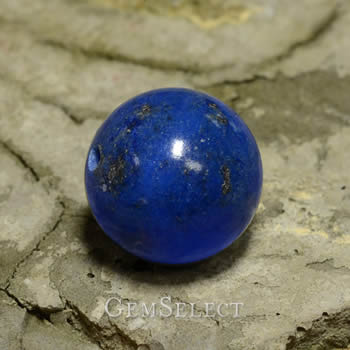Rocks As Gemstones
You will sometimes hear gemstones referred to idiomatically as "rocks", as in "Did you see the size of the rock on her finger?" But while gemstones and rocks both come out of the ground, gemstones are not rocks. There are, however, a few exceptions.
Most gemstones are minerals, each defined by a specific crystal structure and chemical composition. A few gem types, such as amber, pearl and coral, have an organic origin. But none of these are rocks, even the ones that are obviously stones. That's because the term rock has a special meaning in the world of mineralogy.

Lapis Lazuli - Rock and Gemstone
A rock, in mineralogical parlance, is an aggregate of two or more minerals. So a rock, unlike a mineral, need not have a specific chemical composition. Some rocks, such as limestone, are made almost entirely of one mineral (calcite in the case of limestone). Other rocks, such as granite, are more complex; granite typically contains quartz, alkali feldspar and plagioclase feldspar, as well as traces of mica.
The interesting fact about rocks and gemstones is that a few rocks have been accepted as gemstones, due to their unique color or distinctive patterns. Usually shaped as cabochons and then highly polished, these valuable rocks make very attractive jewelry and decorative objects. Here are some of the best known "gemrocks": |
| Lapis Lazuli |
 |
One of the oldest of all gemstone materials, lapis lazuli has been mined in Northern Afghanistan for over 6,000 years. Lapis is made up of 3 different minerals; lazurite, calcite and pyrite. Lazurite, a complex mineral containing sulfur, is the essential ingredient of lapis and gives it a vivid blue color. Calcite is calcium carbonate, a white mineral responsible for the white streaks in many specimens of lapis. Pyrite is iron sulfide, which is white-gold in color and lends lapis its distinctive glitter.
|
| Jasper |
 |
Jasper is usually considered to be a type of chalcedony, but mineralogists place it in a special class because of its grainy structure. Finely-grained, dense jasper contains up to 20% of foreign materials that determine its color, streak and appearance. Uniform jasper is rare. It is usually multicolored, striped, spotted or flamed.
|
| Maw-Sit-Sit |
 |
Maw-sit-sit is one of the most unusual gemstones in the world, due to its curious name and variable chemical composition. It is a recent find that was first identified in 1963 by the late Swiss gemologist, Dr. Edward Gubelin. Maw-sit-sit is considered to be a rock rather than a mineral, since it is composed of a number of different minerals, including kosmochlor (a mineral related to jadeite) and varying amounts of jadeite and albite feldspar. It is often classified as a member of the jade family but it is not really a variety of jadeite.
|
| Ruby-Zoisite |
 |
Also known as anyolite, ruby-zoisite (or ruby-in-zoisite) is a combination of green zoisite and pink red ruby with black streaks of hornblende. It is one of the most colorful ornamental stones found in the world. It was first discovered in 1949 at Longido in Northeast Tanzania at the foot of Mt. Kilimanjaro. The Longido location is still the only source for this fascinating rock.
|
| Obsidian |
 |
Obsidian is a type of naturally occurring glass that forms when volcanic lava cools without crystallizing. Due to its lack of crystal structure, obsidian blade edges can reach almost molecular thinness, leading to its ancient use as arrowheads, and its modern use as surgical scalpel blades. Obsidian was used in antiquity for amulets and necklaces and continues to be popular as a gemstone.
|
| Chyrsocolla |
 |
Chrysocolla is actually a mineral - hydrous copper silicate - rather than a rock, but it is often found mixed with other secondary copper minerals such as malachite, azurite and turquoise, or with quartz. These mixtures provide interesting patterns and textures, and also make the final product harder and more durable than pure chrysocolla.
|
